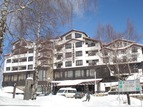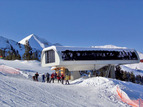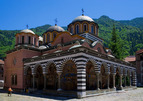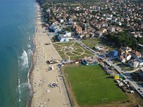Hotels in Assenovgrad
Bachkovo Monastery
Bachkovo Monastery is located on the right bank of the Chepelare river, above the Plovdiv-Smolyan road, 29 km away from Plovdiv, 89 km away from Sofia and 10 km away from Assenovgrad, it is not far from Pamporovo mountain resort.
In XIV century Tsar Ivan Alexander became monastery’s donor. Backdoor monastery’s history in XV and XVI centuries is unknown.
In XVII century a reconstruction of the monastery started. The main (cathedral) Assumption Church and the dining room were built. In 1834 – 1838 the Saint Nicolas of Mirrah Church was constructed in the southern yard.
The main Assumption Church was constructed in 1604 following Mount Athos churches sample. It was painted in 1643 and in 1850.
Narthex murals are preserved from the first period of its painting. The inscription there informs that initially it was dedicated to Saint Virgin of Petrich, after that to Saint Trinity. The murals on the western walls on both sides of the entrance are the most remarkable here. Saints are painted full size with richly decorated cloths, as well as Plovdiv Metropolitan (Bishop) Hristofor and church’s donor, Tzarigrad (Istanbul) merchant Georgi with his son Constantine. Mount Athos’ masters supposedly made murals in the dome. Christ Pantokrator with 16 angels around him is painted in the narthex.
The biggest part of the church was painted anew by Mosko Odrinchanin Zograph in 1850 during Abbot Cyril’s time. The portrait of the Abbot as a donor situated above the pulpit is especially interesting in this painting.
One of the oldest wood-carved iconostases in Bulgarian lands is preserved in the church. Its lower part is an altar barrage made out of freestone. Iconostasis wooden parts tower above it. Talented master made the carved decoration with ornamental patterns space interpretation skill. The first real trellised vine, which later became a permanent part of iconostases decoration, is among them.
In front of the western entrance of Assumption Church narthex Saint Archangels Church is situated. As archeological excavations show it was constructed in XIII century. It is raised on columns forming vaults where ones of the most charming murals of Bulgarian National Revival Period are situated – Gospel Proverbs illustrations. Their author, the famous icons painter Zakhari Zograph has given every day life and reality human characteristics to the images, which gives life to Proverbs’ characters.
Dining room is situated in southern wing of the monastery. It was constructed in the beginning of XVII century together with monastery’s main church. This part of monastery’s complex is always closed due exceptionally valuable frescoes of XVII century. In their artistic qualities they can be compared to the paintings of 1535 in the dining room of Saint Atanasii Great Monastery in Mount Athos. Jesey Tree – Christian saints’ genealogical tree – composition is in the vault. Ancient Philosophers are painted in its basement, being – according to the painter – in the basement of Christian doctrine. Long marble table of 1601 where monks used to eat is preserved in the dining room as well.
Bachkovo Monastery Wonder Worker Icon Procession composition is painted on the dining room’s outside wall. Alexi Atanassov made it in the 60-es of XIX century. All important places in monastery’s vicinity are shown there, as well as participants in famous traditional procession and monastery’s donors with ones of the richest Plovdiv citizens of the time among them.
Saint Nicolas of Mirrah basilica Church constructed in 1834-1838 by local masters is situated outside the old southern monastery wing. Famous painter Zakharii Zograph of Samokov Artistic School is the author of the murals. He was only 30 years old in 1840, when he finished the murals, but was mastering the profession on a very high level for the time.
Being self-confident of his artistic skills, he not only painted all the church with numerous Biblical and Gospel scenes, but made triple fresco portrait in the open arch narthex. He himself, the monastery’s deputy-abbot and the abbot are painted there. In spite of its situation in the upper left part of the wall, this image shows an obvious change in churches’ painting during National Renaissance Period. Plovdiv citizens, dressed in their gorgeous silk clothes are among characters put to torture in the Doomsday composition. Their place is diagonal to the portrait: in the lower right part of the mural.
The Ossuary is the only building preserved from the initial monastery building. It is situated 300m to the east from monastery walls. It is a two-storey stone tomb church and continues old Christian martirias traditions. It is the only tomb church in Orthodox world preserved from Byzantine Komnin dynasty epoch and painted on both floors with frescos. In arch’s vault over the vault there is an inscription with the name of the Zograph Ioan Iviropulos. Frescos have high artistic qualities and are ones of the most valuable artistic ensembles of XI-XII century Byzantine culture. The church is in restoration process, which is to be finished soon.
Since XIII century on Bachkovo monastery together with Stanimaka Fortress was included into two states’ borders: Bulgaria and Byzantine Empire. Nevertheless Georgian traditions continuation was preserved until the beginning of XIV century.
There is a hypothesis that after Bulgaria’s falling under Turkish domination in XIV century, the founder of Tarnovo Literary School, Patriarch Evtimii was exiled in the monastery. Lists of Bulgarian names preserved in monastery’s library show that the monastery has kept up its links with Bulgarian population during Turkish domination period. In XIX century this monastery is the most important spiritual center in the region. In 1894 it was definitely transferred under Bulgarian Exarchate rule and is stavropigale (has an independent statute).
Find out more about Bachkovo Monastery at BulgariaMonasteries.Com
Other places of interest in Assenovgrad
Hotels in Assenovgrad
Places to go in Assenovgrad
Deals & discounts in Assenovgrad
News from Assenovgrad
- Assenova fortress welcomes now visitors
- The project ‘Assenovgrad- the sacred gate of Rhodope Mountain’ approved
- Traditional Bulgarian ‘sedqnka’ in Rhodopes
- The ancient Thracian city of Perperikon
 Member of:
Member of:





























 Touroperator
Touroperator
